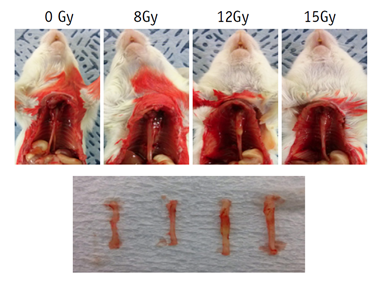글로벌 연구동향
방사선생물학
![[Int J Radiat Oncol Biol Phys.] Radiation-Induced Esophagitis In Vivo and In Vitro Reveals That Epidermal Growth Factor Is a Potential Candidate for Therapeutic Intervention Strategy.](/enewspaper/upimages/admin_20160810111721_R.jpg) 2016년 08월호
2016년 08월호
[Int J Radiat Oncol Biol Phys.] Radiation-Induced Esophagitis In Vivo and In Vitro Reveals That Epidermal Growth Factor Is a Potential Candidate for Therapeutic Intervention Strategy.서울의대, 포항공대 / 김경수, 전성욱, 김학재*, 안지완*
- 출처
- Int J Radiat Oncol Biol Phys.
- 등재일
- 2016 Jul 1
- 저널이슈번호
- 95(3):1032-41. doi: 10.1016/j.ijrobp.2016.02.051. Epub 2016 Feb 23.
- 내용

Balb/C 마우스에서 흉부 방사선조사 후 식도염이 유발됨을 확인함.
Abstract
PURPOSE:
To establish and characterize radiation-induced esophagitis (RIE) in vivo and in vitro.
METHODS AND MATERIALS:
Fractionated thoracic irradiation at 0, 8, 12, or 15 Gy was given daily for 5 days to Balb/c or C57Bl/6 mice. Changes in body weight gain and daily food intake were assessed. At the end of the study, we removed the esophagus and examined histology by hematoxylin and eosin staining, immune cell infiltration and apoptosis by fluorescence-activated cell sorting, and gene expression changes by quantitative real-time polymerase chain reaction. Het-1A human esophageal epithelial cells were irradiated at 6 Gy, treated with recombinant human growth factors, and examined for gene expression changes, apoptosis, proliferation, and signal transduction pathways.
RESULTS:
We observed that irradiation at 12 Gy or 15 Gy per fraction produced significant reduction in body weight and decreased food intake in Balb/c mice but not as much in C57Bl/6 mice. Further analyses of Balb/c mice irradiated at 12 Gy/fraction revealed attenuated epithelium, inflamed mucosa, and increased numbers of infiltrating CD4+ helper T cells and apoptotic cells. Moreover, we found that expression of tissue inhibitor for metalloproteinase-1, plasminogen activator inhibitor-1, granulocyte macrophage-colony stimulating factor, vascular endothelial growth factor, and stromal-derived factor-1 were increased, whereas epidermal growth factor (EGF) was decreased. Irradiated Het-1A cells similarly showed a significant decrease in expression of EGF and connective tissue growth factor (CTGF). Treatment of EGF but not CTGF partially protected Het-1A cells from radiation-induced apoptosis and revealed phosphorylation of EGFR, AKT, and ERK signaling pathways.
CONCLUSIONS:
We established a mouse model of RIE in Balb/c mice with 12 Gy × 5 fractions, which showed reduced body weight gain, food intake, and histopathologic features similar to those of human esophagitis. Decreased EGF expression in the irradiated esophagus suggests that EGF may be a potential therapeutic intervention strategy to treat RIE.
Author information
Kim KS1, Jeon SU2, Lee CJ2, Kim YE2, Bok S2, Hong BJ2, Park DY2, Ahn GO3, Kim HJ4.
1Department of Radiation Oncology, Seoul National University College of Medicine, Seoul, Korea.
2Division of Integrative Biosciences and Biotechnology, Pohang University of Science and Technology, Pohang, Gyeongbuk, Korea.
3Division of Integrative Biosciences and Biotechnology, Pohang University of Science and Technology, Pohang, Gyeongbuk, Korea. Electronic address: goneahn@postech.ac.kr.
4Department of Radiation Oncology, Seoul National University College of Medicine, Seoul, Korea. Electronic address: khjae@snu.ac.kr.
- 연구소개
- 폐암 등 흉부 방사선치료 중 발생하는 가장 흔하고 중대한 합병증인 방사선 식도염의 기전 및 치료법을 개발하고자 시행한 전임상 연구입니다. 본 연구를 통해 방사선 유발 식도염 연구를 위한 동물 모델을 확립하였고, EGF (Epidermal growh factor)의 임상적 이용 가능성을 확인하였습니다. 향후 EGF의 임상 적용을 위해서 스탠트 계발 및 EGF의 제형 변경 등 추가적인 연구의 토대가 될 것으로 생각됩니다.
- 덧글달기







